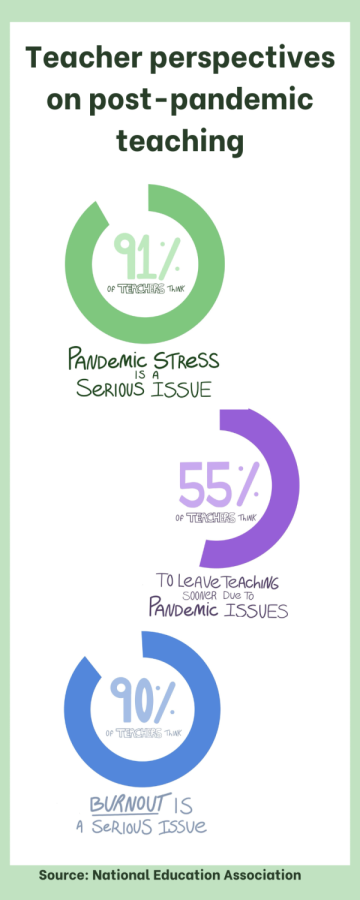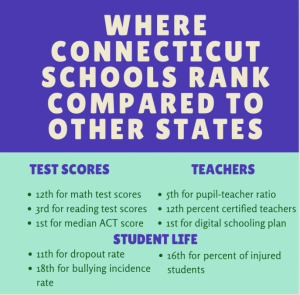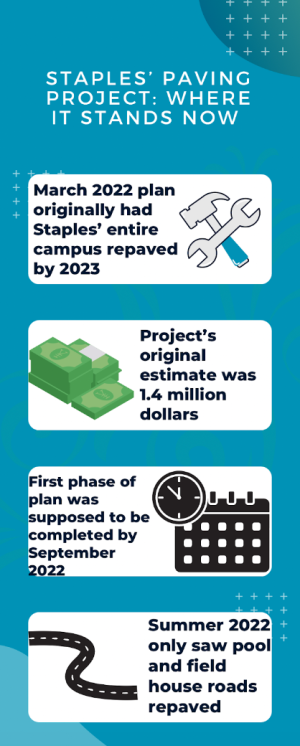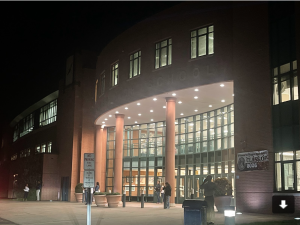Staples struggles to maintain staff amid national teacher shortage
Graphic by Abby DellaValle ’23
Teachers and schools face extreme hardships as a result of the pandemic and its implications on youth.
Staples has experienced increasing resignations and hiring demands as the national teacher shortage affects schools across the country. Amid a shrinking pool of candidates and many resignations, Westport Public Schools (WPS) has, for now, staved off deficits by hiring 24 new teachers for the 2022-2023 school year.
Stephanie Sileo is one of the 24 new teachers who came to Staples this year. She’s taking over for the recently retired Camille Eskell, an arts teacher. Sileo had her career altered by the COVID-19 pandemic. She had to stop her masters of arts program during the pandemic, and in the pause decided that she would get her certification to teach in high school.
“I decided that instead of kind of sitting on the butt and like, you know, feeling a little sad about it,” Sileo said, “I really still wanted to teach art.”
In her process of searching for a job, Sileo felt the benefits of the teacher shortage on opportunities for new hires.
“I don’t wanna say it’s easier,” Sileo said, “but there were more jobs available to me to apply to an interview for than the last, I would say 10 years.”
In the past year, administrators have also noted a shrinking in the pools of potential hires. Principal Stafford W. Thomas Junior attributed a mixture of mask fatigue, low pay, inability to work from home—which was especially dangerous during the height of the pandemic—and complex contentions over race and gender identity to the reduction in teaching’s attraction.
“There hasn’t been a lot that has made us feel attractive in the last three or four years,” Thomas said, “and now we’re seeing the impact of it.”
Presently, all full-time teaching positions in the district have been filled, but administrators report increased difficulty finding qualified long-term substitutes… The English department, for one, has felt the impact of these issues.
English teacher Mary Katherine Hocking, who recently left on maternity leave, does not have a long-term sub to fill her classes. Holly Sulzycki, Coordinator of English/Language Arts, explained that the smaller qualified applicant pool and the amount of full-time employment opportunities for those candidates make filling the position difficult. As a result, Sulzycki assigned Hocking’s classes to existing English teachers.
“I asked people in the department to step up until I could find somebody who I felt confident could actually step into the role,” Sulzycki said.
There are some consequences to using full-time teachers to fill position vacancies. For instance, the teachers responsible for Hocking’s classes now have fewer free periods, must prepare for more classes and their existing students lose out on conference opportunities.
To increase engagement with the teaching profession across the region, Staples stepped up to host graduate courses for teaching interns as part of the CREC Teacher Residency Program. The program allows “underemployed or unemployed adults” and people of color, as per the CREC Foundation’s goals, to receive the education needed to become educators through an 18-month residency without allocating the time and money needed for a master’s in education.
“There’s a long term concern,” John Bayers, Assistant Superintendent of Human Resources and General Administration, said, “about if there’s enough students applying and going into teacher-prep programs.”
Bayers also fosters relationships with nearby universities such as Fairfield University and Sacred Heart University to recruit interested students. In looking for new hires through residency or these relationships, HR keeps in mind Connecticut’s EdSight goals to create more pathways into the workforce and to increase diversity in school districts.
Ultimately, Thomas, Bayers and Sulzycki all agree that challenges that face the profession result in teachers who are more resilient.
“A lot of times it’s a thankless job,” Thomas said. “So you find people who are passionate in the profession, you know, because it’s not one where you get rich or get any greater acclaim.”























































